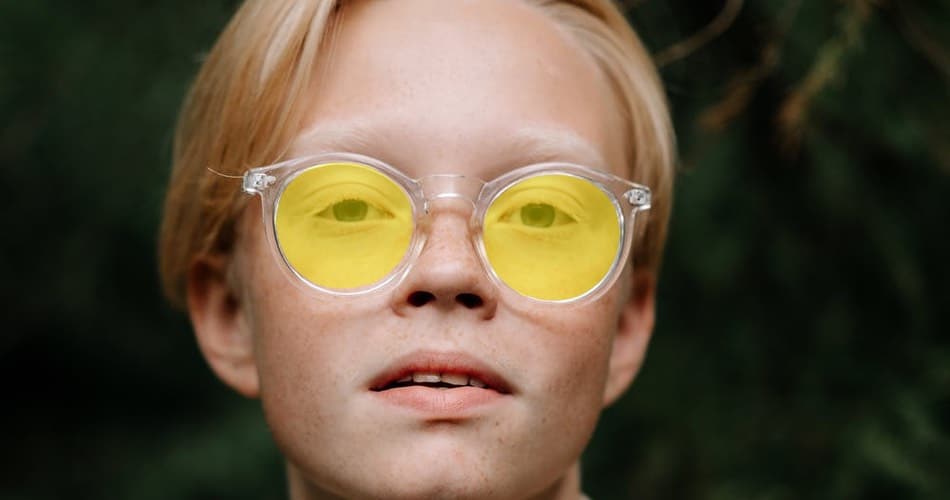In this article you will learn why Some Lenses are Tinted Yellow and where the differences are between the lenses. Yellow lenses are tinted to enhance contrast and simultaneously reducing glare. This can come in handy during the following activities:
- Shooting
- Driving
- Working on your computer
The lenses are able to reduce the glare by blocking a part of the visual light spectrum. They block blue light and do this more effectively than the normal blue-blocking lenses. When a part of the visual spectrum is blocked less light can enter your eye and therefore it gets a little darker.
In my optical shop I oftentimes get asked if those yellow lenses could also be used for driving at night. Because yellow lenses oftentimes get advertised as night driving glasses. And the effect is very much dependent on the evionment you are driving in.
When a lot of headlights are facing you during your drive yellow tinted lenses could make the situation a little better because a lot of headlights have LED or laser technology built in which shines a light which is morel located in the blue spectrum. Of course when you put a blue light filter in front of your eyes when a blue light shines on them things will get better.
But when you are driving on a really dark street and no headlights are facing you your visual experience will turn for the worse with yellow lenses because in an already dark environment with yellow lenses things will get even a little darker. Which of course is definitely not a benefit.
However when the lighting is not optimal yellow lenses can be used to get an edge in regards of the contrast. This is especially the case in visual demanding tasks like shooting, sports in general or as I said in some cases with driving.
Do Yellow Lenses Not Improve Night Driving?
I also have customers in my shop that really like to use yellow lenses while driving at night because they can see a difference. In comparison to the subjective statements of some people, a study from Alex D. Hwang showed different results.
The study is called “Comparison of Pedestrian Detection With and Without Yellow-Lens Glasses During Simulated Night Driving With and Without Headlight Glare” and 22 test subjects were tested with and without yellow lenses for nighttime driving.
Therefore a driving simulator was used and there was no improvement of yellow lenses/glasses over normal clear lenses/glasses. I personally tested various blue light blockers and tried them out looking at different cars. And at best there is a slight improvement when you look at some cars.
But when you have an abnormality on your cornea they did a better job for those customers than compared to people with normal eyes. When we talk about special eyes we should talk about different eye conditions that might indeed benefit from yellow glasses.
Which Eye Conditions Do Benefit From Yellow Lenses?
When glasses prescriptions lead not to satisfying results because of reduced visual acuity special filters like blue light filters can be added to enhance the visual experience. Depending on why the visual acuity is reduced the person testing different filters may like or dislike a certain filter because of the contrast and changed color it provides.

Different filters will come with lighter or darker tints and will block more or less blue light. Usually advertised blue light filters with a minimal yellow tint only filter a small portion of the blue light (only wavelengths smaller than 420nm get blocked). These lenses reduce the blue light exposure slightly but when it comes to degenerative diseases a darker yellow or even a brown tint could work better. In such a case the light filter blocks wavelengths below 450nm for example.
I worked with customers with several degenerative diseases like macular degeneration and some of them really liked standard blue-blocking glasses that have minimal yellow tint while others preferred a darker yellow/orange color in their lenses to reduce glare and improve contrast.
Some of them even use different yellow lenses depending on the lighting they are surrounded by. You could switch them if a clip is used or different glasses entirely. Usually, there are recommendations from which set of filters the wearer of the glasses should choose from. I go through the different options with my customers and let them look through the lenses at best in different lighting. The diseases which I list below bring changes in the eye with them. Which could lead to glare or visual stress. This can be minimized with the correct filter.
- Achromatopsia
- Choroideremia
- Cones rod dystrophy
- Retinitis pigmentosa
- Albinism
- Macular degeneration
In short, there are no uniform objective criteria for prescribing special filter lenses. Rather, the selection of the appropriate special filter lens takes place through trial and error, especially in the case of degenerative eye diseases such as retinitis pigmentosa or diabetic retinopathy.
Patients make the selection of the optimal filter lens by comparing and evaluating the visual comfort provided by different filter lenses. Patients decide which filter lens is best for their needs by comparing and assessing visual comfort through different filter lenses. For this purpose, binocular holders are available to be held in front of the pair of eyes or filter clips to be attached to the glasses.
Oftentimes the improvement of filters are rather subjective. In some cases the customer feels better less blinded by the glare but can actually not read finer print. In other cases in my optical shop experience a noticeable improvement. In such a case some customers could indeed read text significantly smaller compared to without the filter.
I hope you found the information you were looking for about yellow tinted lenses. I wish you a great day.
